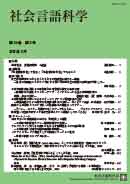Volume 24, Issue 2
Displaying 1-14 of 14 articles from this issue
- |<
- <
- 1
- >
- >|
Obituary
-
2022 Volume 24 Issue 2 Pages 1-2
Published: March 31, 2022
Released on J-STAGE: May 21, 2022
Download PDF (1002K)
Prefatory Note
-
2022 Volume 24 Issue 2 Pages 3-4
Published: March 31, 2022
Released on J-STAGE: May 21, 2022
Download PDF (188K)
Research Papers
-
2022 Volume 24 Issue 2 Pages 5-20
Published: March 31, 2022
Released on J-STAGE: May 21, 2022
Download PDF (485K) -
2022 Volume 24 Issue 2 Pages 21-36
Published: March 31, 2022
Released on J-STAGE: May 21, 2022
Download PDF (685K) -
2022 Volume 24 Issue 2 Pages 37-50
Published: March 31, 2022
Released on J-STAGE: May 21, 2022
Download PDF (555K) -
2022 Volume 24 Issue 2 Pages 51-66
Published: March 31, 2022
Released on J-STAGE: May 21, 2022
Download PDF (444K) -
2022 Volume 24 Issue 2 Pages 67-82
Published: March 31, 2022
Released on J-STAGE: May 21, 2022
Download PDF (1209K)
Short Notes
-
2022 Volume 24 Issue 2 Pages 83-90
Published: March 31, 2022
Released on J-STAGE: May 21, 2022
Download PDF (523K) -
2022 Volume 24 Issue 2 Pages 91-98
Published: March 31, 2022
Released on J-STAGE: May 21, 2022
Download PDF (413K) -
2022 Volume 24 Issue 2 Pages 99-106
Published: March 31, 2022
Released on J-STAGE: May 21, 2022
Download PDF (210K)
Book Reviews
-
2022 Volume 24 Issue 2 Pages 107-111
Published: March 31, 2022
Released on J-STAGE: May 21, 2022
Download PDF (310K) -
2022 Volume 24 Issue 2 Pages 112-115
Published: March 31, 2022
Released on J-STAGE: May 21, 2022
Download PDF (296K) -
2022 Volume 24 Issue 2 Pages 116-121
Published: March 31, 2022
Released on J-STAGE: May 21, 2022
Download PDF (307K) -
2022 Volume 24 Issue 2 Pages 122-125
Published: March 31, 2022
Released on J-STAGE: May 21, 2022
Download PDF (300K)
- |<
- <
- 1
- >
- >|
